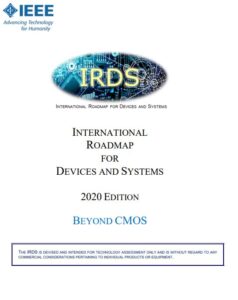Topological transistors added to IEEE International Roadmap for Devices and Systems

The IEEE semiconductor roadmap’s Beyond CMOS chapter features future digital logic technologies beyond the scaling limits of CMOS
The remarkable advances in semiconductor technology (guided by the so-called ‘Moore’s Law’ over some six or seven decades) don’t just happen. They are steered through an international, pre-competitive industry roadmap.
The IEEE International Roadmap for Devices and Systems ‘IRDS’ is the latest semiconductor roadmap, guiding development of more conventional silicon-based CMOS electronics as well as an array of alternative and complementary future technologies.
For FLEET science to become more visible worldwide, particularly with the international semiconductor industry, it was vital that it be included in the IEEE roadmap, and this task was facilitated in 2020 by FLEET AI Prof Francesca Iacopi.
FLEET-relevant science is now included in the ‘Beyond CMOS’ Chapter, including:
- Topological insulator electronic devices (new in 2020)
- Excitonic devices
- Domain wall logic.
The inclusion of FLEET’s science in IRDS will ensure that the industrial R&D leaders in semiconductors are aware of such work, and will be able to consider FLEET’s breakthroughs among the potential solutions for future low-energy electronics, hence fulfilling the Centre’s mission.
The 2020 edition predicts present and future technological needs, encompassing the immense scope of the electronics industry—particularly wrt semiconductors and computing — from applications needs to device and manufacturing requirements, accommodating cloud computing, cyber-physical systems, mobile technologies, and Internet of Things (IoT).

FFLEET Scientific Associate Investigator Prof Francesca Iacopi(University of Technology Sydney) sits on the Emerging Materials working group for the 2020 IEEE roadmap
In terms of future electronics, the other important parts of the roadmap are:
- ‘More Moore’ – further developments in traditional integrated circuits: hopefully extending Moore’s Law a few more years
- ‘More than Moore’ – extending beyond traditional technology
- Cryogenic electronics and quantum computing.
The roadmap also covers ‘conventional’ CMOS electronics, including application benchmarking, systems and architectures, packaging integration, outside system connectivity, factory integration, lithography, metrology, OHS and yield enhancement.
The IEEE semiconductor roadmap can be viewed at the IRDS website. To download you need to join the IEEE IRDS Technical Community (it’s free. Instructions here). Relevant chapters are available for FLEET members on the private Centre intranet.
IRDS stands for the International Roadmap for Devices and Systems, with previous iterations being the International Technology Roadmap for Semiconductors (ITRS, 1998-2013) and National Technology Roadmap for Semiconductors (NTRS, 1990s).
The Institute of Electrical and Electronics Engineers (IEEE) is the world’s largest professional organisation for the advancement of technology.
Also see
- IEEE Rebooting computing initiative
- 2020 NSW chief scientist and engineer plan to deliver a Roadmap for NSW participation in semiconductor industry
- FLEET video presentations in Ascend program (starts from 14:00).

